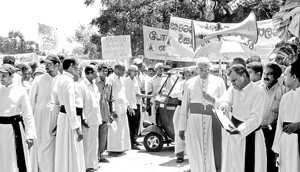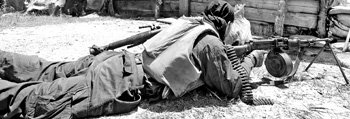
Bishop defends shifting of statue as Madhu war hots up
What the Government's political leaders have been longing for - the long drawn out military campaign to gain control of the Madhu Church and its environs, sacred to the country's Catholics -- is now so close and yet so far. This week, troops advancing on a flank east of the Giant's Tank, have come to within a kilometre of the Church. This is by reaching Madhu Road at a location south of the Church. An advance by another group from an undisclosed location somewhere ahead, when completed, Army officials say, would seal off the area.
The successful execution of such a task would see the accomplishment of the main aim of the military thrust in the Mannar sector. That is the re-capture of the area surrounding the Church. The military offensive for this purpose began on July 2, last year, nine months ago; this was soon after the Government declared that almost the entirety of the East has been re-captured. Another aim, for which troops are still advancing west of the Giant's Tank area, is to seize control of Vidattaltivu where a major Sea Tiger base is located. The final military thrust in the Madhu area has assumed greater significance for a number of reasons. This is a victory, which Government leaders are waiting for and have been very keen to accomplish. For that reason, military leaders are equally keen to deliver without loss of further time. The offensive began even before the Cabinet decision on January 2, this year, to abrogate the Norwegian brokered Ceasefire Agreement of 2002. Thereafter, the military thrust in the Mannar sector formed the main effort of the Government in its "war on terror" or the beginning of Eelam War IV. Thus, the new campaign to weaken the Tiger guerrillas militarily began here. It is in this backdrop that both political and military leaders vowed publicly to defeat the guerrillas before the end of 2008. Military leaders said the guerrillas would be "extinct" come December 31. Later some extended the deadline to next year or even thereafter. Others said no deadlines can be given. This process of estimation and under-estimation is a culture in the more than two decades of separatist war. Hence, advertising coming attractions and putting them off before they arrive should not come as a surprise to those who are keen students of the conflict in Sri Lanka. Those proposed "successes" are as good as the foundations on which they are built - the spiralling casualty counts that rise faster than the lightning speed of bullets. This is despite positive ground realities like re-capture of guerrilla-dominated areas and other aspects which media wizards in uniform and outside it cannot project. In the battle areas of Madhu, what the coming days and weeks portend is no secret. Having denied the area for the military by resisting an advance for the past nine months, the guerrillas are digging themselves for bigger battles. "The forces may arrive in Mannar tomorrow. The following day we will be in Medawachchiya," boasted Rasiah Ilanthiriyan, the "Military Spokesman" for the Liberation Tigers of Tamil Eelam (LTTE), in an interview with the Australian Tamil Broadcasting Corporation. The text of the interview was later released by the LTTE. Bringing the greater Mannar area under their control and opening a route along Mannar-Pooneryn axis (to Jaffna) is important for them, says Ilanthiriyan. "What are the losses for the armed forces during this war that has spawned over a year?" he asks and adds "we will fight for it intensely". He adds: "With set time frames for themselves and not publicly, operations are being carried out by playing a mere numbers game. They are unable to avoid this……" "Ilanthiriyan's remarks are gung ho and idle talk," says a senior Army official in Mannar. "We did not set time frames for our offensives here. We have re-captured substantial territory, inflicted heavy casualties on the guerrillas and even captured sizeable quantities of their weaponry," he said speaking on grounds of anonymity. The maps on this page in the past weeks showed that troops have seized a considerable area in the Mannar sector during their advance on two flanks, one from west and the other from east of the Giant's tank.
"Morale is high and the troops will accomplish their task soon," the officer said. He, however, declined to say whether the area would come under Security Forces control before next week's National New Year. "Our troops are in battle and not in a competition where we could use stop watches to accomplish tasks," he shot back. Rain had dogged their planning for the coming days. Bunkers are under water. The terrain ahead is muddy but troops continue to man their positions and counter guerrilla attacks. Fears of escalated fighting have prompted the shifting from the Madhu church the most sacred statue of "Our Lady of Madhu" on Thursday evening by members of the clergy. It had been moved northwards from Madhu to Thevan Peddi Church in Tiger guerrilla dominated Mulangavil located northwards beyond Periyamadu in the Mannar district. On Friday, Army Commander Lt. Gen. Sarath Fonseka visited Mannar area to discuss the ground situation with senior field commanders in the area. He was later quoted by the Daily News as saying that priests at the Madhu Church "have acted in the Tigers' interest as they were under LTTE pressure" in shifting the statue of Our Lady of Madhu. That was a clear indication that the LTTE has lost control of the area and their inability to hold the ground, he had said. Lt. Gen. Fonseka's visit to Mannar came just a week after President Mahinda Rajapaksa met senior officers of the Army and Navy engaged in the Northern theatre. At a meeting of the National Security Council on Friday March 28, he sought their views on the prevailing ground situation. He raised several questions and made notes of progress made in several sectors, including Mannar. President Rajapaksa, who is both Minister of Defence and Commander-in-Chief, since assuming office in November 2005, had further modernised the Security Forces and ensured a growth in their strength. Through his personal interaction, Government sources said, he had assessed how the troops were making progress particularly in the light of heavy expenditure the Government was incurring on its top priority exercise, the "war on terror." Some important aspects regarding this matter including losses, casualties and heavy costs involved, beneficial to the public to make a fuller assessment of the situation, cannot be freely discussed due to personal constraints. Lt. Gen. Fonseka's remarks drew an angry response from the Rt. Rev. Rayappu Joseph, the Bishop of Mannar. He said, "We are not under the pressure of the LTTE. We never get into anybody's pressure. We decide on our own. We never yield to pressure from the LTTE or the Sri Lanka Army. Of course we will listen to both parties but make our own decisions." Bishop Rayappu said he and other members of the Catholic clergy in the area made a careful study of the ground situation before taking a decision to shift the Sacred Statue of Our Lady of Madhu. "I gave the order to do so," he said. Yesterday, the Bishop celebrated Special Mass at St. Sebastian's Cathedral in Mannar town to bless the Madhu shrine area. He later held a meeting with 27 parish priests at the same Cathedral. Rt. Rev. Joseph and Rev. Father Victor Soosai will travel to Kilinochchi tomorrow for a meeting with LTTE Political Wing leader, P. Nadesan. The Sunday Times asked Bishop Rayappu why the Sacred Statue of Our Lady of Madhu was taken to a church located in an LTTE-dominated area. He was also asked why it could not be brought to a church in a Government-controlled area. His response: "We took the decision after taking into consideration the ground realities and were pressured by no one. The Madhu shrine is located in the LTTE-dominated or "uncleared" area. So was the sacred statue. The people in the South have forgotten this. We cannot move around as we want. If we have to come to the South, we have to first go to Kilinochchi and thereafter to Vavuniya. Our priority is to make sure the sacred statue is kept safe. We would urge both the Army and the LTTE to leave the Madhu shrine area."
Bishop Rayappu said communications with the Madhu Church area were completely broken down. "I don't know what is happening there. We do not have any information," he said. He added: "Let people in the south not make wrong accusations or come to wrong conclusions against us. We love this country and I will co-operate with anyone yearning for peace. I am always available and no one should get trapped in false propaganda." As previously reported, most of the battles in the Mannar sector have been largely through the exchange of artillery and mortars by the two sides. Troops advancing had to clear improvised mines and other explosive devices during their advance. A sizeable number of guerrilla casualties have been female and young cadres. Intelligence sources said the guerrillas may be saving some of their hard core strength for heavier confrontations both in the Mannar and the Weli Oya sectors. These sources said the troops were alive to this reality. In the Weli Oya sector where troops are advancing on a stretch near the north-east coast, ahead of Ethawetunuwewa and Janakapura, heavy rains had impeded activity. It is in this backdrop that a sizeable number of troops have been afflicted with Chikungunya and a lesser number with dengue. The Ministry of Defence has already effected a phased troop re-deployment plan. Notwithstanding the Provincial Council elections in the East on May 10, detachments of the Police Special Task Force in the Ampara district are now in the process of being shifted to the Vavuniya district. Soldiers in another battalion earmarked to be re-located became the victims of a natural disaster. Troops of the Eighth Battalion of the Sri Lanka Army's Signals Corps were on a 20-day refresher course at the Jungle Training School in Katukeliya in Minneriya. One evening when they were at games in a playground, there had been thunder and lightning. The men moved to a tent covered by corrugated zinc sheets. Lightning hit a tree and thereafter the tent, killing five soldiers and 61 suffered shock and were admitted to the Polonnaruwa Hospital. These developments come at a time when the Government is taking steps to further equip the armed forces. The latest is a multi-million dollar deal to provide four new MiG-29 fighter jets to the Sri Lanka Air Force. The Chief Executive Officer of Lanka Logistics and Technologies Ltd., Jayantha Wickremasinghe, has confirmed this to the Jane's Defence Weekly. A report by John Grevatt, Jane's Asia Pacific Industry Reporter based in Bangkok in the JDW issue of March 19 states: "Sri Lanka is in advanced talks with Russia over the procurement of five MiG-29 fighter aircraft, the head of the country's state-owned procurement agency has said. "Jayantha Wickremasinghe, Chief Executive Officer of Lanka Logistics and Technologies (the company created by the Sri Lankan Ministry of Defence in 2007 to procure equipment for the armed forces), said that the acquisition of four MiG-29SMs and one MiG-29UB was "well under way." "Negotiations about these aircraft are continuing," Wickremasinghe told Jane's on 13 March. "We are discussing all possibilities." "The aircraft would also augment four overhauled MiG-27s that were received by the SLAF in 2006 and 2007 from Ukrinmarsh, Ukraine's state-owned defence organisation. "Although he would not divulge further details about the potential procurement of the MiG-29s, which would cost around US $ 75 million, Wickremasinghe implied that Sri Lanka was also advancing the acquisition of a number of other military platforms. He said: "What is required by the Sri Lankan armed forces is the sort of equipment required by any modern force. We are going ahead with the procurement plans - but I am unable to be more specific at this time." "Along with the procurement of new fighter aircraft from Russia, Colombo has plans for the acquisition of a number of other defence items, including mobile radars, utility helicopters, attack craft for the Sri Lanka Navy and transport vehicles and combat equipment for the Sri Lankan Army. "To help pay for these acquisitions, Colombo has set a 2008 defence budget of LKR 166.4 billion (US D 1.51 billion): an increase of 20 per cent on official spending of LKR 139.6 billion a year earlier." Creating modern forces as Eelam War IV is under way is no easy task. It would require enormous expenditure. Now that the political and military leaders have said defeating the guerrillas will go beyond 2008, into 2009 or further, financial commitments in those years would, no doubt, be staggering. That is at a time when, for the average Sri Lankan, living costs are becoming unbearable and prices of consumer items are skyrocketing. That is the grim truth which some are frightened of and want to hide. |
|
||||||
|| Front
Page | News | Editorial | Columns | Sports | Plus | Financial
Times | International | Mirror | TV
Times | Funday
Times || |
| |
Reproduction of articles permitted when used without any alterations to contents and a link to the source page.
|
© Copyright
2008 | Wijeya
Newspapers Ltd.Colombo. Sri Lanka. All Rights Reserved. |


